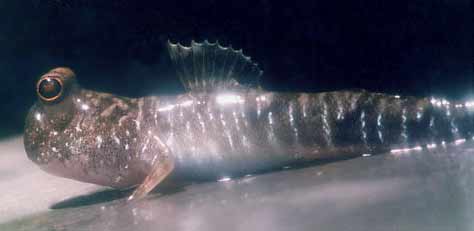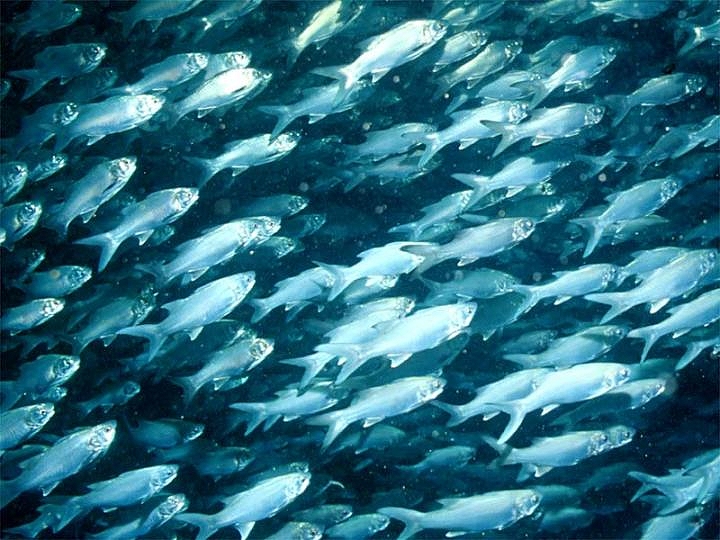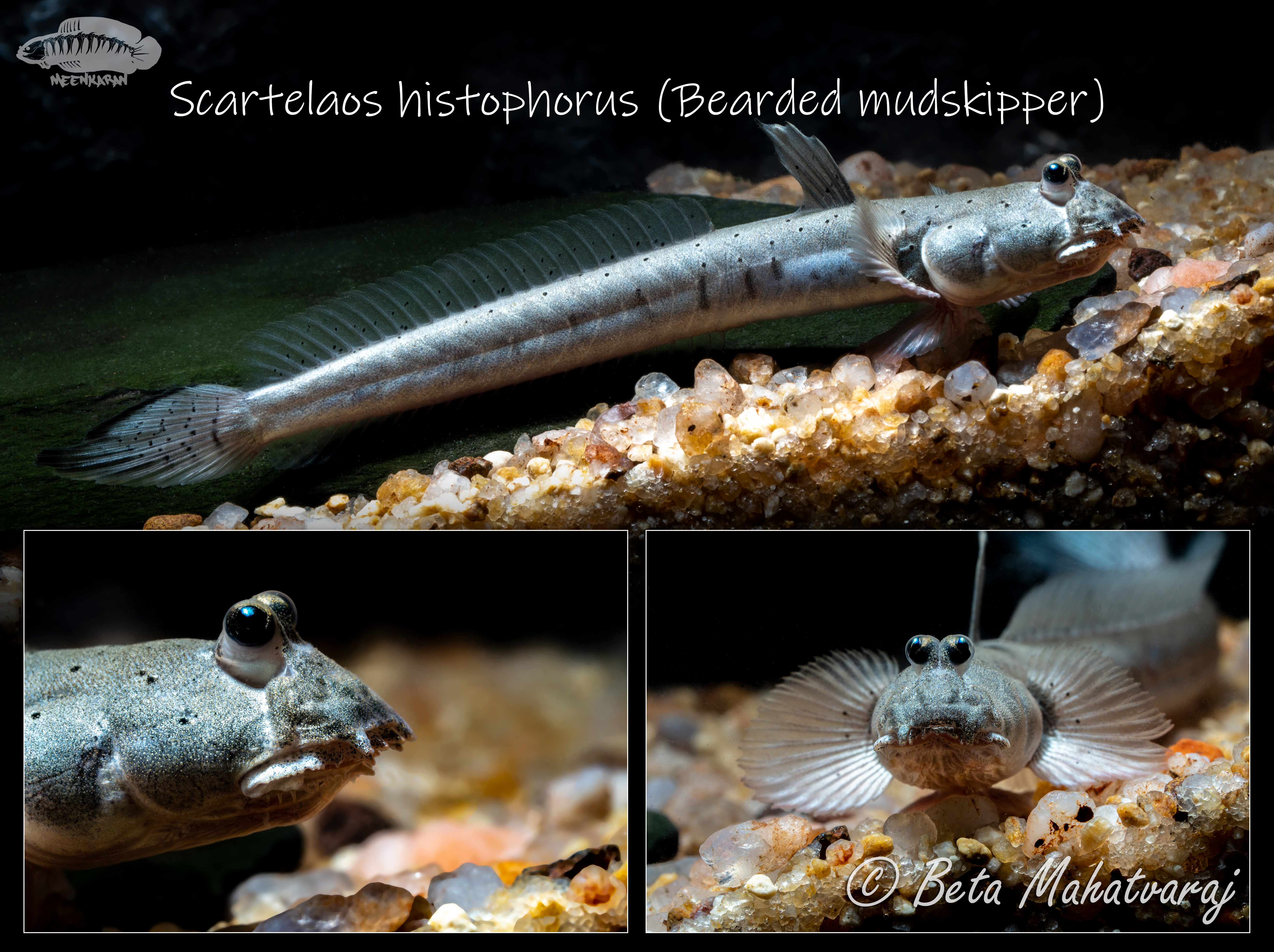|
Mudskipper
Mudskippers are any of the 23 extant species of amphibious fish from the subfamily Oxudercinae of the goby family Oxudercidae. They are known for their unusual body shapes, preferences for semiaquatic habitats, limited terrestrial locomotion and jumping, and the ability to survive prolonged periods of time both in and out of water. Mudskippers can grow up to long, and most are a brownish green colour that range anywhere from dark to light. During mating seasons, the males will also develop brightly coloured spots in order to attract females, which can be red, green or blue. Unlike other fish, the mudskipper's eyes protrude from the top of its flat head. Their most noticeable feature however is their side pectoral fins that are located more forward and under their elongated body. These fins are jointed and function similarly to limbs, which allow the mudskipper to crawl from place to place. Although having the typical body form of any other gobiid fish, these front fins all ... [...More Info...] [...Related Items...] OR: [Wikipedia] [Google] [Baidu] |
Periophthalmus
''Periophthalmus'' is a genus of fish in the family Oxudercidae, native to coastal mangrove wood and shrubland in the Indo-Pacific region, except for ''P. barbarus'' from the Atlantic coast of Africa. It is one of the genera commonly known as mudskippers. All ''Periophthalmus'' species are aggressive and territorial. Species There are currently 19 recognized species in this genus * ''Periophthalmus argentilineatus'' Valenciennes, 1837 (Barred mudskipper) * ''Periophthalmus barbarus'' (Linnaeus, 1766) (Atlantic mudskipper) * ''Periophthalmus chrysospilos'' Bleeker, 1852 * ''Periophthalmus darwini'' Larson & Takita, 2004 (Darwin's mudskipper)Larson, H.K. & Takita, T. (2004): Two New Species of ''Periophthalmus'' (Teleostei: Gobiidae: Oxudercinae) from Northern Australia, and a re-diagnosis of ''Periophthalmus novaeguineaensis''. ''The Beagle: Records of the Museums and Art Galleries of the Northern Territory, 20: 175-185.'' * '' Periophthalmus gracilis'' Eggert, 1935 (Graceful ... [...More Info...] [...Related Items...] OR: [Wikipedia] [Google] [Baidu] |
Periophthalmodon
''Periophthalmodon'' is a genus of mudskippers found along muddy shores, estuaries and lower reaches of rivers in Southeast Asia, Papua New Guinea and Queensland, Australia. Species There are currently three species in the genus: * ''Periophthalmodon freycineti'' ( Quoy & Gaimard, 1824) (Pug-headed mudskipper) * ''Periophthalmodon schlosseri'' (Pallas, 1770) (Giant mudskipper) * ''Periophthalmodon septemradiatus ''Periophthalmodon septemradiatus'' is a species of mudskipper found along tropical shorelines of the eastern Indian Ocean where it occurs in marine, brackish and fresh waters from India to Indonesia. It is found along in estuaries as well as i ...'' ( F. Hamilton, 1822) References Mudskippers Oxudercinae Amphibious fish {{Gobiiformes-stub ... [...More Info...] [...Related Items...] OR: [Wikipedia] [Google] [Baidu] |
Amphibious Fish
Amphibious fish are fish that are able to leave water for extended periods of time. About 11 distantly related genera of fish are considered amphibious. This suggests that many fish genera independently evolved amphibious traits, a process known as convergent evolution. These fish use a range of terrestrial locomotory modes, such as lateral undulation, tripod-like walking (using paired fins and tail), and jumping. Many of these locomotory modes incorporate multiple combinations of pectoral-, pelvic-, and tail-fin movement. Many ancient fish had lung-like organs, and a few, such as the lungfish and bichir, still do. Some of these ancient "lunged" fish were the ancestors of tetrapods. In most recent fish species, though, these organs evolved into the swim bladders, which help control buoyancy. Having no lung-like organs, modern amphibious fish and many fish in oxygen-poor water use other methods, such as their gills or their skin to breathe air. Amphibious fish may also have e ... [...More Info...] [...Related Items...] OR: [Wikipedia] [Google] [Baidu] |
Zappa Confluentus
''Zappa confluentus'', the New Guinea slender mudskipper, is a mudskipper endemic to New Guinea, where it is only known from the lower parts of the Fly, Ramu and Bintuni Rivers. It is found on mudflats adjacent to turbid rivers. This species can reach a length of SL. Etymology ''Zappa'' was named after musician Frank Zappa "for his articulate and sagacious defense of the First Amendment of the U.S. Constitution". See also *List of organisms named after famous people (born 1900–1949) In biological nomenclature, organisms often receive scientific names that honor a person. A taxon (e.g. species or genus; plural: taxa) named in honor of another entity is an eponymous taxon, and names specifically honoring a person or persons ar ... References Mudskippers Fish of New Guinea Taxa named by Tyson R. Roberts Fish described in 1978 Frank Zappa Oxudercinae Endemic fauna of New Guinea {{PapuaNewGuinea-stub ... [...More Info...] [...Related Items...] OR: [Wikipedia] [Google] [Baidu] |
Boleophthalmus
''Boleophthalmus '' is a genus of mudskippers native to the Indian Ocean and the western Pacific Ocean. Species There are currently six recognized species in this genus: * '' B. birdsongi'' Murdy, 1989 (Birdsong's mudskipper) * '' B. boddarti'' (Pallas, 1770) (Boddart's goggle-eyed goby) * '' B. caeruleomaculatus'' McCulloch & Waite, 1918 (Bluespotted mudskipper) * '' B. dussumieri'' Valenciennes, 1837 * '' B. pectinirostris'' ( Linnaeus, 1758) * '' B. poti'' Polgar, Jaafar & Konstantinidis, 2013 References Bibliography * Eschmeyer, William N. 1990. ''Genera of Recent Fishes''. California Academy of Sciences. San Francisco. iii + 697. . * Eschmeyer, William N. (ed.) 1998. ''Catalog of Fishes''. Special Publication of the Center for Biodiversity Research and Information, #1, vol. 1–3. California Academy of Sciences The California Academy of Sciences is a research institute and natural history museum in San Francisco, California, that is among the largest mus ... [...More Info...] [...Related Items...] OR: [Wikipedia] [Google] [Baidu] |
Oxudercidae
Oxudercidae is a family of gobies which consists of four subfamilies which were formerly classified under the family Gobiidae. The family is sometimes called the Gobionellidae, but Oxudercidae has priority. The species in this family have a cosmopolitan distribution in temperate and tropical areas and are found in marine and freshwater environments, typically in inshore, euryhaline areas with silt and sand substrates. The Oxudercidae includes 86 genera, which contain around 600 species. This family has many species which occur in fresh water, and a number of species found on wet beaches and are able to live for a number of days out of water. The family includes the mudskippers, which include species that are able to move over land with quite quickly. They have eyes located on the top of their heads on short stalks. They are capable of elevating or retracting them, and they can see well out of water. One species, '' Gillichthys mirabilis'', usually stays in the water, but surfaces ... [...More Info...] [...Related Items...] OR: [Wikipedia] [Google] [Baidu] |
Paraphyletic
In taxonomy, a group is paraphyletic if it consists of the group's last common ancestor and most of its descendants, excluding a few monophyletic subgroups. The group is said to be paraphyletic ''with respect to'' the excluded subgroups. In contrast, a monophyletic group (a clade) includes a common ancestor and ''all'' of its descendants. The terms are commonly used in phylogenetics (a subfield of biology) and in the tree model of historical linguistics. Paraphyletic groups are identified by a combination of synapomorphies and symplesiomorphies. If many subgroups are missing from the named group, it is said to be polyparaphyletic. The term was coined by Willi Hennig to apply to well-known taxa like Reptilia ( reptiles) which, as commonly named and traditionally defined, is paraphyletic with respect to mammals and birds. Reptilia contains the last common ancestor of reptiles and all descendants of that ancestor, including all extant reptiles as well as the extinct synaps ... [...More Info...] [...Related Items...] OR: [Wikipedia] [Google] [Baidu] |
Pectoral Fins
Fins are distinctive anatomical features composed of bony spines or rays protruding from the body of a fish. They are covered with skin and joined together either in a webbed fashion, as seen in most bony fish, or similar to a flipper, as seen in sharks. Apart from the tail or caudal fin, fish fins have no direct connection with the spine and are supported only by muscles. Their principal function is to help the fish swim. Fins located in different places on the fish serve different purposes such as moving forward, turning, keeping an upright position or stopping. Most fish use fins when swimming, flying fish use pectoral fins for gliding, and frogfish use them for crawling. Fins can also be used for other purposes; male sharks and mosquitofish use a modified fin to deliver sperm, thresher sharks use their caudal fin to stun prey, reef stonefish have spines in their dorsal fins that inject venom, anglerfish use the first spine of their dorsal fin like a fishing rod to lur ... [...More Info...] [...Related Items...] OR: [Wikipedia] [Google] [Baidu] |
Terrestrial Locomotion
Terrestrial locomotion has evolved as animals adapted from aquatic to terrestrial environments. Locomotion on land raises different problems than that in water, with reduced friction being replaced by the increased effects of gravity. As viewed from evolutionary taxonomy, there are three basic forms of animal locomotion in the terrestrial environment: * legged – moving by using appendages * limbless locomotion – moving without legs, primarily using the body itself as a propulsive structure. * rolling – rotating the body over the substrate Some terrains and terrestrial surfaces permit or demand alternative locomotive styles. A sliding component to locomotion becomes possible on slippery surfaces (such as ice and snow), where location is aided by potential energy, or on loose surfaces (such as sand or scree), where friction is low but purchase (traction) is difficult. Humans, especially, have adapted to sliding over terrestrial snowpack and terrestrial ice by means of ... [...More Info...] [...Related Items...] OR: [Wikipedia] [Google] [Baidu] |
Semiaquatic
In biology, semiaquatic can refer to various types of animals that spend part of their time in water, or plants that naturally grow partially submerged in water. Examples are given below. Semiaquatic animals Semi aquatic animals include: * Vertebrates ** Amphibious fish; also several types of normally fully aquatic fish such as the grunion and plainfin midshipman that spawn in the intertidal zone ** Some amphibians such as newts and salamanders, and some frogs such as fire-bellied toads and wood frogs. ** Some reptiles such as crocodilians, turtles, water snakes and marine iguanas. ** Penguins. ** Some rodents such as beavers, muskrats and capybaras. **Some insectivorous mammals such as desmans, water shrews and platypuses. ** Some carnivoran mammals, including seals, polar bears and otters. ** Hippopotamuses. * Semiterrestrial echinoderms of the intertidal zone, such as the "cliff-clinging" sea urchin '' Colobocentrotus atratus'' and the starfish '' Pisaster o ... [...More Info...] [...Related Items...] OR: [Wikipedia] [Google] [Baidu] |
Intertidal Fish
Coastal fish, also called inshore fish or neritic fish, inhabit the sea between the shoreline and the edge of the continental shelf. Since the continental shelf is usually less than deep, it follows that pelagic coastal fish are generally epipelagic fish, inhabiting the sunlit epipelagic zone.Moyle and Cech, 2004, page 585 Coastal fish can be contrasted with ''oceanic fish'' or ''offshore fish'', which inhabit the deep seas beyond the continental shelves. Coastal fish are the most abundant in the world. They can be found in tidal pools, fjords and estuaries, near sandy shores and rocky coastlines, around coral reefs and on or above the continental shelf. Coastal fish include forage fish and the predator fish that feed on them. Forage fish thrive in inshore waters where high productivity results from upwelling and shoreline run off of nutrients. Some are partial residents that spawn in streams, estuaries and bays, but most complete their life cycles in the zone.Moyle and Cech ... [...More Info...] [...Related Items...] OR: [Wikipedia] [Google] [Baidu] |
Scartelaos
''Scartelaos'' is a genus of gobies native to the coasts of the Indian Ocean and the western Pacific Ocean. Species There are currently four recognised species in this genus: * ''Scartelaos cantoris'' ( F. Day, 1871) * ''Scartelaos gigas'' Y. T. Chu & H. W. Wu, 1963 * ''Scartelaos histophorus'' (Valenciennes, 1837) (Walking goby) * ''Scartelaos tenuis ''Scartelaos'' is a genus of gobies native to the coasts of the Indian Ocean and the western Pacific Ocean. Species There are currently four recognised species in this genus: * ''Scartelaos cantoris'' ( F. Day, 1871) * ''Scartelaos gigas'' Y. T ...'' ( F. Day, 1876) (Indian Ocean slender mudskipper) References Oxudercinae {{Gobiiformes-stub ... [...More Info...] [...Related Items...] OR: [Wikipedia] [Google] [Baidu] |



.png)


